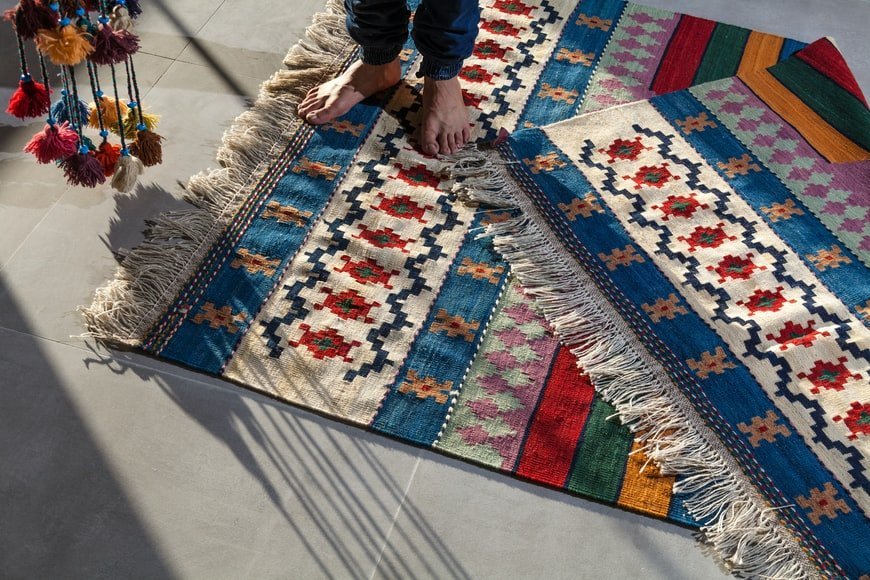Some Popular Rug Types And How To Take Care Of Them
by Sumona Real Estate Published on: 15 November 2021 Last Updated on: 06 February 2023

There are multiple rug types available with various shapes and materials on the market. The most common are polypropylene (derived from petroleum), Arraiolos, Persian, Kilim, Sisal, Fur, Skin, Belgian, Chinese, and Cotton. Below we explain each of these types for you to understand a little better of the carpet you have at home.
There are varieties of carpets available in the market. But no matter which type of carpets you buy, you require proper cleaning and care. You can take services from professional cleaning companies like Crown Cleaners for heavy rugs and rug cleaning.
10 Popular Rug Types

Hundreds of rug types mean they have a thousand different characteristics. So when you know the fabric types of the individual carpet types and the quality. You can easily get rid of it without taking any professional help. But for better cleaning, a professional touch is going to be required.
1. Polypropylene:
Polypropylene rug types are made with synthetic fibers. This type of rug can have yellowish stains caused by the concentration of liquids, such as water and urine. In the case of urine, the risk of the stain not coming out due to the high acidity rate is very high, which causes fixation on the threads and, in some cases, leads to fiber rot.
A characteristic of polypropylene carpets is the appearance of frayed threads after cleaning. This is because, at the time of manufacture, the thread goes through a twisting process and, during cleaning, it goes through a twisted process, which results in a frayed appearance.
2. Arraiolos:
Arraiolos rugs are made with natural wool fiber. Most of the rug is handcrafted, so when there is excess water, it becomes crooked, as it does not have a support base.
In industrialized Arraiolos carpets, color migration can also occur due to excessive dyeing in the factory.
3. Persian:
Persian rug types are made of natural wool and dyed with natural dyes (flowers, roots, vegetables). Some are handcrafted, and others industrialized. The original ones are made by artisans, and there are reports of rugs where the manufacture takes approximately 400 days.
After completion, this type of carpet goes through a process of burning the excess fibers of the carpet and then washing with a lot of water. For this type of rug, there is no risk of color migration.
The underside of the rug also forms drawings, each with its meanings and origins. Persian rugs should be cleaned carefully by a professional carpet cleaning like Carpet Cleaning Brixton.
4. Kilim:
Kilim rug types are made of natural fiber, stand out for their geometric designs, and can be used on both sides. They are very similar to a hammock.
5. Sisal:
Sisal rug types are made of natural fiber from desert cacti. Water should not be injected into this type of carpet, as the cactus fiber absorbs a lot of liquid, causing it to become “swollen” and, over time, deformed and full of dark stains.
If this happens, there is no way to remove the stain, as the carpet absorbs the liquid very quickly. Cleaning it must be done in parts.
6. Leather:
The leather rug types are made naturally, usually with the cowhide itself. In this material, no mechanical scrubbing should be done, nor the continuous use of water.
7. Fur:
The fur rug types are made of sheep’s wool, with totally handcrafted manufacture. The wool is glued to a high friction mat, which can cause the fleece to shift from the mat. In dyed wool rugs, it is necessary to carry out cleaning in parts. In some cases, this type of rug may have a bad odor at the end of the process.
8. Belgian:
The Belgian rug is made with acrylic viscose and cotton fringe. This mat has a low relief appearance and does not have a support base. When cleaning, pay attention to tears, as this is a fine-textured rug type. At the end of cleaning, the carpet fibers may appear stiff, but this is normal.
9. Chinese:
The Chinese rug types are made of wool, silk, or cotton, so they must be cleaned in parts. There are models of the Chinese rug embossed. It is necessary to be aware of the appearance of yellowish spots due to excess water.
10. Cotton:
Cotton rug types are made of raw cotton. This type of rug is made of jute or sisal, so if there is excess water, yellowish stains can occur after the carpet is completely dried. However, stains do not appear when it is wet, so it is necessary to be careful and perform cleaning in parts.
Conclusion:
All of these ten rug types have pretty impressive looks and design-wise. But only you can maintain the gloss of the carpet when you are going to follow an excellent cleansing regime. We hope this information was helpful.
Read Also:







































































































